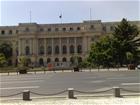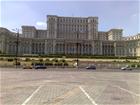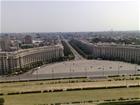Romania - on Stand-by Agreement but not Quite on Stand-by Growth
Zhaneta Kuyumdzhieva, May 21, 2012
 In the beginning of May, on a Friday, representatives of the IMF, the European Commission and the World Bank published their assessment of Romania's progress on its economic programme. Their visit to Romania between May 24 and May 9 2012 was a good opportunity for the trio to establish relations with the new government in the country and to make sure that it would follow the course of the previous cabinet, led by Emil Bok. A little after their arrival, though, they found out that their talks would not be with the expected interlocutor. The government of Mihai Ungureanu lost a non-confidence vote on the 27th of April and a mandate to form government was given to Victor Ponta, a social democrat.
In the beginning of May, on a Friday, representatives of the IMF, the European Commission and the World Bank published their assessment of Romania's progress on its economic programme. Their visit to Romania between May 24 and May 9 2012 was a good opportunity for the trio to establish relations with the new government in the country and to make sure that it would follow the course of the previous cabinet, led by Emil Bok. A little after their arrival, though, they found out that their talks would not be with the expected interlocutor. The government of Mihai Ungureanu lost a non-confidence vote on the 27th of April and a mandate to form government was given to Victor Ponta, a social democrat.
From the report of the experts two main things can be drawn out: that a confirmation of sticking to the commitments has been received, in spite of the political castling, and that 2012 hides reasonable fears that the hardly won good results so far could be reversed because of the overall recession on the Old continent.
The economic situation in Romania today must be viewed in the context of the last two stand-by agreements of the country with the IMF. The blow of the 2008 crisis on the financial markets, the increasing costs on external loans, the pressure on banks and their low liquidity have led to the need the country to conclude such a type of loan contract. The first (after the beginning of the crisis) stand-by agreement is of 4th of May 2009 and expired on March 30th last year. The total amount of the agreement was 12.95 bn euro from the IMF, 5 bn from the EU and the World Bank participated with a billion. In exchange to this assistance, Romania was expected to implement a set of reforms, dealing with the sharp decline of private capital flow, to maintain adequate capitalisation of banks and liquidity of the internal financial markets, to reduce inflation to the admissible for the central bank levels, to attract appropriate funding and thus to achieve better sustainability of its economy.
The recession in our northern neighbour in 2009 was 7% - a result of the decline of exports and domestic demand. The European Commission launched an excessive deficit procedure in July the same year. The initially planned period for bringing the deficit down within 3% of GDP was by 2011. The external environment deteriorated, though, and this was a reason for a revision of the deadline to 16th of August this year. But it is a fact that the undertaken strict measures have led to improvement of the general condition of the country. The latest review of the implementation of commitments on the transitional stand-by agreement of March 2011 shows that the process of "healing" of Romania's economy has started.
Inflation has dropped to 7.6% in 2011 from 8% in 2010; the deficit is reduced; and  the increased industrial production has led to exports growth. Negative impact have bad loans, the number of which was growing to the beginning of 2011, but the experts think that the existing buffers would mitigate the effect and the banking sector would remain relatively viable. Although the overall picture of Romania's economy looks significantly better in 2011 than in 2009, the achieved results could be a condition for long-term sustainability only if the pace of the agreed structural reforms gets accelerated, on which the progress of the country by the spring of last year was relative.
the increased industrial production has led to exports growth. Negative impact have bad loans, the number of which was growing to the beginning of 2011, but the experts think that the existing buffers would mitigate the effect and the banking sector would remain relatively viable. Although the overall picture of Romania's economy looks significantly better in 2011 than in 2009, the achieved results could be a condition for long-term sustainability only if the pace of the agreed structural reforms gets accelerated, on which the progress of the country by the spring of last year was relative.
It is on them that the second stand-by agreement focuses, in force from the 31st of March 2011 which will last till the 30th of March 2013. The loan under this agreement is 3.5 bn euros from the IMF, 1.4 from the EU and 0.4 from the World Bank. The accents, under the current financial agreement, are related to reforms, aimed at ensuring more jobs and therefore more growth, and to improve the standard of living of the Romanian citizens. The tasks of the new government are related to deregulation of prices of natural gas, to privatisation of key companies in various sectors of the economy, improving health care services and a more effective application of fiscal measures.
On the basis of the data from the fourth regular programme review of April 2012, the experts of the IMF, the EU and the World Bank forecast economic growth of 1.5%, based mainly on domestic demand; inflation levels are low, although there is a risk of slight increase this year; the current account deficit will be around 4.5-5% of GDP in 2012; and the bank sector would remain sound. The risks of recession in the eurozone, however, bespeak of the need Romania to continue to create a set of financial and fiscal buffers.
 The country's progress under the economic programme is reviewed extensively in several areas:
The country's progress under the economic programme is reviewed extensively in several areas:
- The undertaken administrative measures for unregistering VAT companies;
- Taking stock of achieved results in tax collection;
- Prioritising the policies of deregulation of gas prices and electricity;
- Restructuring state-owned companies and attracting private investments;
- Reform the health care legislation with the purpose of optimising expenses and providing better health services.
One of the areas, in which Romania is doing relatively well, is EU funds absorption. Given the expectations of reduced external demand throughout the year, the efforts focused on correct spending of money under EU programmes will provide a good basis for supporting growth. The government aims to absorb 6 bn euros this year: 3.5 bn euros from the Structural and Cohesion Fund and 2.5 bn from the funds for agriculture, for rural areas development and for fisheries.
In spite of the forecast for weaker growth, the experts of the trio are optimistic about maintaining the deficit to 2.1% of GDP through over implementation of tax collection. Measures have been undertaken for optimisation of the work of the National Agency for Fiscal Policy by closing 141 regional offices and 8% of the jobs by the end of 2010. In addition, by the end of 2012 it is envisaged the government to present a draft plan, in cooperation with the World Bank, for multiannual framework for modernisation of the tax administration.
The structural reforms in the area of energy and transport appear to be among the  biggest challenges Romania is facing. The government has committed to create an energy market and to apply the European directives in the sector. By January 2014 it is expected the prices of electricity for the industry to be formed on market principles. And from the beginning of 2013 it is envisaged work to start on the plan for deregulation of the electricity prices for households. In the end of last month the government had to have completed the draft legislation on a package of tax and regulatory measures for the extraction, production, preservation and distribution of fossil fuels. Liberalisation is envisaged of the price of natural gas for the business and households, as well as measures for protection of vulnerable consumers.
biggest challenges Romania is facing. The government has committed to create an energy market and to apply the European directives in the sector. By January 2014 it is expected the prices of electricity for the industry to be formed on market principles. And from the beginning of 2013 it is envisaged work to start on the plan for deregulation of the electricity prices for households. In the end of last month the government had to have completed the draft legislation on a package of tax and regulatory measures for the extraction, production, preservation and distribution of fossil fuels. Liberalisation is envisaged of the price of natural gas for the business and households, as well as measures for protection of vulnerable consumers.
The report of the experts finds weak implementation of the set objectives for handling the state-owned enterprises that generate losses. The authorities in Romania prepare for privatisation four companies, which is with 3 less than planned in the third review of the economic programme. Work is going on on renegotiating the conditions of unprofitable contracts of state-owned enterprises. In companies in the area of transport and infrastructure reforms are also under way, because they are at risk of piling unserviced debt, the payment of which could fall on the budget.
 One of the problems many economies in the European Union suffer of is health care. Here the commitments of Romania are essential, given the fact that it is one of the countries that spend the least money for this sector as a share of GDP. By the middle of the year, the authorities have to be ready with a revised framework of the law (after the first draft legislation failed due to strong public discontent). The new framework will focus on possibilities for private management of hospitals, additional gathering of financial resources and there will be clarity what additional services, financed by the private sector, would be included in the public health care package. In the meantime, several decisions for spending cuts are under way, aimed at reducing the budget-funded stay in hospitals, about revising payments for medication, transferring the duties to collect health care contributions to the Fiscal Policy Agency, etc.
One of the problems many economies in the European Union suffer of is health care. Here the commitments of Romania are essential, given the fact that it is one of the countries that spend the least money for this sector as a share of GDP. By the middle of the year, the authorities have to be ready with a revised framework of the law (after the first draft legislation failed due to strong public discontent). The new framework will focus on possibilities for private management of hospitals, additional gathering of financial resources and there will be clarity what additional services, financed by the private sector, would be included in the public health care package. In the meantime, several decisions for spending cuts are under way, aimed at reducing the budget-funded stay in hospitals, about revising payments for medication, transferring the duties to collect health care contributions to the Fiscal Policy Agency, etc.
Another four reviews are to take place before the current stand-by agreement expires. Romania's economic growth in the mid-term is expected to reach 3.5-4% in the period 2013-2016. Investments will be a key driver for growth, although some of the planned in the first semester of 2012 investments will be delayed for the second half of the year or for 2013. This year expires the deadline for deficit correction and up to date it seems that the procedure will be suspended, given the country's ability to reduce it to 2.8% in 2012.
seems that the procedure will be suspended, given the country's ability to reduce it to 2.8% in 2012.
Undoubtedly, history is full of examples that Romania can surprise. Now, given the figures in the report, the country shows good progress. But nonetheless, Brussels is on the alert, judging from the words of Olli Rehn, EU monetary affairs commissioner, when he presented the Commission spring economic forecast. On the occasion of Romania he said that the country was on critical crossroads with improved economic perspectives. He hoped that the new Romanian government would continue the course of reforms. That this is the right course is evident from the presented forecast for expected sound economic growth of our northern neighbour.